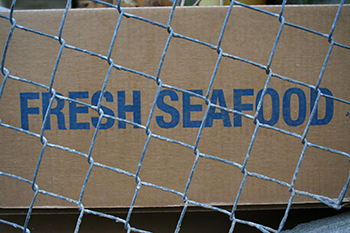As a 20-something college student, I didn’t start thinking about where my food comes from until recently. Big-name supermarkets seemed like the only option financially and, aside from an occasional trip to the local farmer’s market, that’s where I bought all of my groceries.
Since I’ve been working at National Fisherman (and realized that Domino’s pizza doesn’t count as a well-balanced meal), I’ve been thinking more about what my food goes through before it winds up on my plate.
Rachael Voorhees photo.This week I spoke with Tyson Fick, the communications director for the Alaska Seafood Marketing Institute, about the recent events regarding Alaska pollock. Now, legally, only pollock from Alaskan waters can be labeled as “Alaska pollock,” fighting lower-quality Russian products that wind up on the market bearing the state’s name.
As a consumer with little knowledge of the seafood industry prior to being hired at NF, I was a little taken aback. They were allowed to do that? Isn’t that lying?
Thankfully, that isn’t allowed anymore. But after talking to Fick about this from a marketing perspective, I realized the battle isn’t over. He says ASMI is set to work on a few educational campaigns for consumers.
Just because it’s easier to pick out Alaska seafood now, doesn’t mean consumers are going to be or are thinking about labels at all.
My girlfriend prepared some salmon for dinner last week and I asked her where it was from. “Hannaford,” she said. That’s one of the biggest supermarket chains in the Northeast.
Just a few weeks ago at a family Christmas party, a little tray of shrimp was plopped down in front of me. The week before I had written a blog post about the Associated Press investigation that traced slave-peeled shrimp from Thailand to the shelves of major U.S. retailers. I didn’t want to damper the holiday spirit by discussing slavery, but I couldn’t help thinking about it. This is in central Maine, by the way, not fresh-off-the-boat-seafood coastal Maine. If there was any venison at the table, I would’ve known the deer was probably shot by my neighbor.
There has been a lot of backlash because of that AP report, but not as much as there should be. Seafood Source confirmed yesterday that some U.S. supermarket chains are boycotting Thailand shrimp now. But it sounds like the chain Seafood Source spoke with, left unnamed in the story, chose to do so as a PR precaution, not because of demands from their customers.
The retailer noted that “only two customers asked about the Thai slavery allegations.” I think it’s safe to assume that the rest of their customers weren’t silently protesting and went about buying their shrimp as usual.
Convenience is king in U.S. markets, and consumers can be quick to pick up the first generically labeled seafood product they see most days. The difference in quality and the businesses behind the product may seem obvious to anyone involved in the industry, but the average consumer just doesn’t think about it.
Hopefully the Alaska pollock name restrictions and the revealing of Thailand’s crueler labor practices means selling more seafood caught by U.S. fishermen. But we can’t assume that will happen because of one bill or news story. Be sure to share your expertise whenever you get that chance and make people start thinking about where their seafood comes from.







